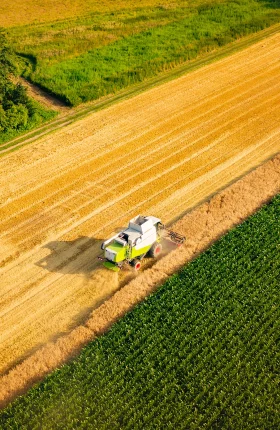Companies can use seaweed to advance decarbonization and create other benefits, including improved marine ecosystem health.
When you think about natural solutions for combating climate change , the first things that likely come to mind are forests, thanks to their vital role in capturing and storing carbon. What is probably not top of mind is seaweed. But it should be.
When left undisturbed, an acre of seaweed can sequester as much as 20 times the amount of carbon that can be removed by an acre of trees. Companies in many industries—including consumer packaged goods , chemicals , packaging , and agribusiness —can take advantage of the powerful sequestration potential of seaweed to reduce scope 3 greenhouse gas emissions in their supply chain. At the same time, seaweed farming can also yield other important benefits, such as helping to restore marine ecosystems and creating new jobs. However, as seaweed demand rises, the global supply is unlikely to keep pace in the near term.
That’s why governments must focus now on creating the appropriate regulatory and policy framework to support the growth of seaweed farming. Such frameworks will enable companies to realize the potential of seaweed in combating climate change. They can integrate it as an ingredient in many applications (including food, feed, packaging, agriculture, construction, and cosmetics), while ensuring that a significant portion of cultivated seaweed is left in place as a carbon sink. Whether companies operate seaweed farms themselves or partner with other players, such efforts can be a powerful way to help halve greenhouse emissions by 2030 and meet net-zero commitments.
The Underleveraged Potential of Seaweed
As with trees on land, seaweed traps atmospheric carbon through photosynthesis. As seaweed breaks and falls to the ocean floor to decompose, carbon is embedded in the sea floor. The current stock of seaweed around the world sequesters 1.1 tons of carbon per 2.5 acres per year, according to the nonprofit organization Project Drawdown. And by 2050, the seaweed stock could store 1.84 to 2.28 gigatons of carbon—the equivalent of 61% to 76% of the yearly emissions of all the cars in the world.
The carbon sequestration potential of seaweed has significant implications not only for the overall warming of the planet but also for the health of the ocean. The State of the Global Climate 2021, a report by the World Meteorological Organization, states that the world’s oceans are a carbon sink for 23% of anthropogenic CO2. Both the use of carbon by marine life (such as seaweed) and the direct absorption of CO2 by ocean water account for that percentage. However, the latter increases the acidity of ocean waters. If greenhouse gas emissions continue on their current trajectory, oceans could become 150% more acidic by the end of the century, according to the National Oceanic and Atmospheric Administration, an agency within the US Department of Commerce. That rising acidity, together with increasing ocean temperatures, poses a major threat to marine ecosystems (including fish populations) and has already contributed to the loss of some 50% of the world’s coral reefs.
Seaweed can help create a virtuous cycle by absorbing carbon, which promotes healthier marine ecosystems and seaweed growing conditions.
Seaweed can help counteract rising acidity while also limiting the impact of nitrogen and phosphorous runoff from agriculture into the ocean. This can create a virtuous cycle in which seaweed absorbs carbon, promoting healthier marine ecosystems and seaweed growing conditions. Such benefits are desperately needed at a time when ocean health in general is being degraded. (See “The Peril for Marine Ecosystems.”)
The Peril for Marine Ecosystems
Roughly one-third of monitored fisheries around the world are overfished, according to The State of the World Fisheries and Aquaculture, which was published in 2020 by the Food and Agriculture Organization of the United Nations. Moreover, human-generated noise pollution, offshoring drilling disasters, and the increase in the amount of plastic waste dumped into oceans (pegged at more than 8 million tons of plastic every year by the UN Environment Programme) are all altering the underwater ecosystem. And the rate of ocean pollution is set to worsen if nothing is done.
At the same time, human activities continue to destroy vital marine ecosystems. Mangroves are not only a major carbon sink but also a support for overall ecosystem health. Unfortunately, the rate of mangrove deforestation is three to five times that of terrestrial deforestation, and the estimated decline in global mangrove coverage from 1990 through 2020 was roughly 5,343 square
It’s no surprise, then, that seaweed is garnering more attention from climate experts. Seaweed Revolution: A Manifesto for a Sustainable Future, a report initiated by Lloyd’s Register Foundation and supported by the United Nations Global Compact, has drawn attention to the potential of seaweed to combat climate change. And Project Drawdown recently updated its landmark list of potential climate change levers to include seaweed farming.
However, climate change poses a threat to seaweed, as well as to other plants (including seagrass) that support marine ecosystems. For example, increasing acidification, combined with human activities (such as coastal development) and urban, industrial, and agricultural runoff, have triggered a 7% decline in seagrass per year, according to the UN report Out of the Blue: The Value of Seagrasses to the Environment and to People. The report notes that the decline is equivalent to losing a football field of seagrass every 30 minutes. Meanwhile, businesses are more focused on other nature-based solutions, such as
reforestation
and regenerative agriculture, to sequester carbon in trees and in soil. As a result, seaweed farming remains a relatively underdeveloped market: almost all of the seaweed grown for harvesting is in Asia; the seaweed industry is still immature in Europe, North America, and Africa. Amid such constraints, the demand for seaweed is likely to outstrip the available supply in the coming years, leading to a period of
scarcity
for this critical sustainability resource.
Seaweed Farming as a Driver of Net Zero
Current guidelines from the Science Based Targets initiative on nature-based solutions only permit companies to offset 5% to 10% of their total emissions in order to reach a net-zero target. However, the current guidelines do allow a higher percentage to be counted if a company adopts sustainable practices within its own supply chain—an approach known as “insetting.” This means for companies to truly get value from seaweed in their net-zero journey, it has to be part of their core operations . To achieve this, companies need to carefully integrate seaweed into their value chain, balancing increasing seaweed in their product or packaging with the risk of harvesting it and no longer leaving seaweed in the oceans to sequester carbon.
Using such an approach, companies can leverage seaweed in a variety of potential ways, including:
- Food Ingredient. Seaweed has an attractive nutrient profile, containing many nutritious elements, including collagen, amino acids, carbohydrates, fats, protein, and vitamins, as well as trace elements, such as iron. The demand for seaweed as a snack and food ingredient is increasing. Seaweed can also be incorporated into animal feed as a low-emission replacement for other feeds, including soy or wild fish, with benefits such as improved animal health and a reduction in the use of antibiotics.
- Animal Feed Additive. When seaweed is included as an additive in animal feed, it has the potential to significantly mitigate the methane (a powerful greenhouse gas) that cattle release during enteric digestion.
Enteric digestion accounts for 44% of the total greenhouse gas emissions from cattle, according to the Food and Agriculture Organization of the United Nations. Researchers have found that cows belched out 82% less methane after putting a small amount of red seaweed in their feed for five
months.2 2 “Red Seaweed (Asparagopsis Taxiformis) Supplementation Reduces Enteric Methane by Over 80 Percent in Beef Steers,” PLOS.org, March 17, 2021. Early pilots have shown the potential to mitigate emissions, though the results have yet to be proven at scale. - Biopackaging. Seaweed can be used as packaging that is 100% renewable and biodegradable. Moving to seaweed packaging can reduce plastic production and its contamination effects on soil, water, and air, while also avoiding the release of toxic substances that kill marine life and destroy natural habitats.
- Biofertilizer and Biostimulant. Research has highlighted the potential for seaweed to be used as a biofertilizer or biostimulant, each of which, in small amounts, can stimulate the growth of organic soil mass, improve soil health, and increase carbon removal.
Beyond its direct applications for companies, seaweed has other uses. For example, many indigenous peoples who live along coastlines use kelp (a fast-growing seaweed) to collect herring roe during spawning season. Seaweed may also yield medicines down the road. Some types of green seaweed have anticancer properties and are being investigated as potential treatments and preventatives. Seaweed has also been found to have biologically active compounds that prevent or reduce arthritis, diabetes, and heart problems.
How Governments Can Help Spur Seaweed Farming
For the seaweed industry to flourish, governments need to play a role in two areas.
The first relates to regulation. A stable political and regulatory framework would facilitate the scaling of seaweed farming. Some governments are leading on this front. Namibia, for example, has set clear rules for seaweed farming, including regulations on the amount of seaweed that operators can harvest daily. That regulatory clarity has sparked increased investment in kelp farms off the Namibia coast.
Governments should update and harmonize seaweed-farming regulations within their own borders and with other nations.
Still, in most places, clear rules for seaweed farming do not exist. And the permitting process is complex, typically involving multiple agencies and taking as long as 18 to 36 months. On top of that, there is little harmonization of rules among countries, making it a challenge for multinational companies to scale seaweed operations. That’s why governments should update and harmonize seaweed-farming rules and regulations within their own borders and with other nations, an effort that is being led by organizations such as Seaweed for Europe.
The second area where governments must play a role is in finding ways to expand expertise in seaweed farming. In partnership with the private sector, governments should help grow a workforce that has knowledge about valuable end uses, cultivation, and harvesting, for example. Seaweed farms will generate jobs and economic value, but they require know-how, which is at a much lower level in Europe and the US than it is in Asia. Building that expertise will create a virtuous cycle that creates more opportunity to grow seaweed.
Seaweed farming at scale offers a win-win-win solution. It creates a powerful emissions-reduction opportunity. It can yield environmentally friendly and sustainable products and materials. And it can spur the creation of jobs related to cultivation and harvesting—including in biotechnology, engineering, factory support services, and logistics—leading to positive economic ripple effects.
To capture this opportunity, companies should be actively looking to integrate seaweed into their supply chain on the basis of a regenerative harvesting approach. At the same time, governments should look for ways to create a supportive regulatory environment to enable the seaweed industry to take off. When that happens, seaweed can become a powerful component in the drive to reach net zero.










